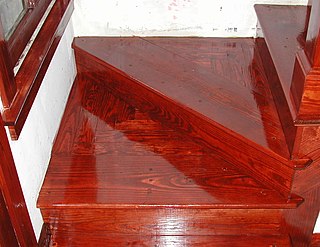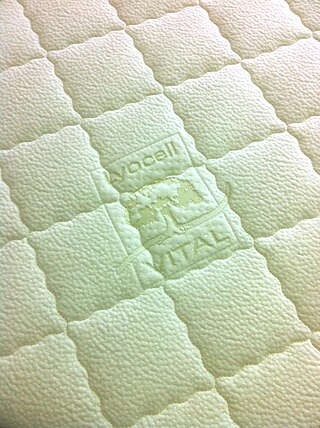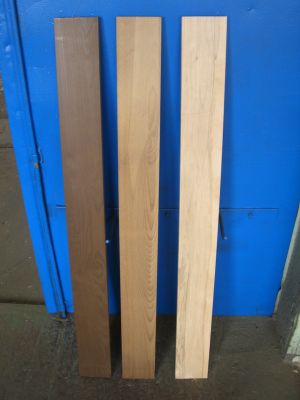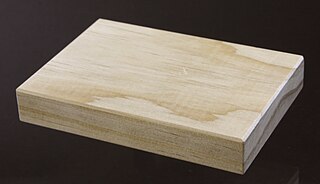
Waxes are a diverse class of organic compounds that are lipophilic, malleable solids near ambient temperatures. They include higher alkanes and lipids, typically with melting points above about 40 °C (104 °F), melting to give low viscosity liquids. Waxes are insoluble in water but soluble in nonpolar organic solvents such as hexane, benzene and chloroform. Natural waxes of different types are produced by plants and animals and occur in petroleum.

Epoxy is the family of basic components or cured end products of epoxy resins. Epoxy resins, also known as polyepoxides, are a class of reactive prepolymers and polymers which contain epoxide groups. The epoxide functional group is also collectively called epoxy. The IUPAC name for an epoxide group is an oxirane.

Varnish is a clear transparent hard protective coating or film. It is not to be confused with wood stain. It usually has a yellowish shade due to the manufacturing process and materials used, but it may also be pigmented as desired. It is sold commercially in various shades.

Wood easily degrades without sufficient preservation. Apart from structural wood preservation measures, there are a number of different chemical preservatives and processes that can extend the life of wood, timber, and their associated products, including engineered wood. These generally increase the durability and resistance from being destroyed by insects or fungi.

Lyocell is a semi-synthetic fiber used to make textiles for clothing and other purposes. It is a form of regenerated cellulose made by dissolving pulp and dry jet-wet spinning. Unlike rayon made by the more common viscose processes, Lyocell production does not use carbon disulfide, which is toxic to workers and the environment. Lyocell was originally trademarked as Tencel in 1982.
An artificial membrane, or synthetic membrane, is a synthetically created membrane which is usually intended for separation purposes in laboratory or in industry. Synthetic membranes have been successfully used for small and large-scale industrial processes since the middle of the twentieth century. A wide variety of synthetic membranes is known. They can be produced from organic materials such as polymers and liquids, as well as inorganic materials. Most commercially utilized synthetic membranes in industry are made of polymeric structures. They can be classified based on their surface chemistry, bulk structure, morphology, and production method. The chemical and physical properties of synthetic membranes and separated particles as well as separation driving force define a particular membrane separation process. The most commonly used driving forces of a membrane process in industry are pressure and concentration gradient. The respective membrane process is therefore known as filtration. Synthetic membranes utilized in a separation process can be of different geometry and flow configurations. They can also be categorized based on their application and separation regime. The best known synthetic membrane separation processes include water purification, reverse osmosis, dehydrogenation of natural gas, removal of cell particles by microfiltration and ultrafiltration, removal of microorganisms from dairy products, and dialysis.
An ionomer is a polymer composed of repeat units of both electrically neutral repeating units and ionized units covalently bonded to the polymer backbone as pendant group moieties. Usually no more than 15 mole percent are ionized. The ionized units are often carboxylic acid groups.

Polyester is a category of polymers that contain one or two ester linkages in every repeat unit of their main chain. As a specific material, it most commonly refers to a type called polyethylene terephthalate (PET). Polyesters include naturally occurring chemicals, such as in plants and insects, as well as synthetics such as polybutyrate. Natural polyesters and a few synthetic ones are biodegradable, but most synthetic polyesters are not. Synthetic polyesters are used extensively in clothing.

Furfuryl alcohol is an organic compound containing a furan substituted with a hydroxymethyl group. It is a colorless liquid, but aged samples appear amber. It possesses a faint odor of burning and a bitter taste. It is miscible with but unstable in water. It is soluble in common organic solvents.
Pultrusion is a continuous process for manufacture of fibre-reinforced plastics with constant cross-section. The term is a portmanteau word, combining "pull" and "extrusion". As opposed to extrusion, which pushes the material, pultrusion pulls the material.
Polyester resins are synthetic resins formed by the reaction of dibasic organic acids and polyhydric alcohols. Maleic anhydride is a commonly used raw material with diacid functionality in unsaturated polyester resins. Unsaturated polyester resins are used in sheet moulding compound, bulk moulding compound and the toner of laser printers. Wall panels fabricated from polyester resins reinforced with fiberglass—so-called fiberglass reinforced plastic (FRP)—are typically used in restaurants, kitchens, restrooms and other areas that require washable low-maintenance walls. They are also used extensively in cured-in-place pipe applications. Departments of Transportation in the USA also specify them for use as overlays on roads and bridges. In this application they are known AS Polyester Concrete Overlays (PCO). These are usually based on isophthalic acid and cut with styrene at high levels—usually up to 50%. Polyesters are also used in anchor bolt adhesives though epoxy based materials are also used. Many companies have and continue to introduce styrene free systems mainly due to odor issues, but also over concerns that styrene is a potential carcinogen. Drinking water applications also prefer styrene free. Most polyester resins are viscous, pale coloured liquids consisting of a solution of a polyester in a reactive diluent which is usually styrene, but can also include vinyl toluene and various acrylates.

2-Acrylamido-2-methylpropane sulfonic acid (AMPS) was a Trademark name by The Lubrizol Corporation. It is a reactive, hydrophilic, sulfonic acid acrylic monomer used to alter the chemical properties of wide variety of anionic polymers. In the 1970s, the earliest patents using this monomer were filed for acrylic fiber manufacturing. Today, there are over several thousands patents and publications involving use of AMPS in many areas including water treatment, oil field, construction chemicals, hydrogels for medical applications, personal care products, emulsion coatings, adhesives, and rheology modifiers. Lubrizol discontinued the production of this monomer in 2017 due to copy-cat production from China and India destroying the profitability of this product.
Kebony is a Norwegian wood producer, which manufactures furfurylated wood. The company has its roots in Wood Polymer Technologies (WPT), which was founded in 1996 and changed its name to Kebony in 2007. Kebony has a factory in Skien (Norway) and in Antwerp (Belgium).
Impregnation resins are slightly viscous, organic liquids that are used in the forest products industry for wood modification. They typically contain formaldehyde and are composed of dimers and trimers of the main molecule. These can become polymer solutions upon curing inside of a wood substrate, imparting stabilizing properties. Impregnation of these resins involves a vacuum chamber procedure that completely disperses the resin into the wood. Once inside of the wood, the resin can diffuse into the cell wall and enhance the physical strength of the wood even further.
Wood stabilization is a series of processes which use pressure and/or vacuum to impregnate wood cellular structure with certain monomers, acrylics, phenolics or other resins to improve dimensional stability, biological durability, hardness, and other material properties. When exposed to moisture through humidity absorption or direct immersion, most wood species will swell and change shape. When moisture comes into contact with wood, the water molecules penetrate the cell wall and become bound to cell wall components through hydrogen bonding. With addition of water to the cell wall, wood volume increases nearly proportionally to the volume of water added. Swelling increases until the fiber saturation point has been reached. Wood stabilization limits water absorption into the wood structure, thereby limiting the dimensional changes which arise from moisture exposure.

Thermally modified wood is engineered wood that has been modified by a controlled pyrolysis process of wood being heated to (> 180 °C) in an oxygen free atmosphere. This process changes to the chemical structures of wood's cell wall components lignin, cellulose and hemicellulose which decreases its hygroscopy and thus increases dimensional stability. Low oxygen content prevents the wood from burning at these high temperatures. Several different technologies use different media including nitrogen gas, steam and hot oil. All processes degrade strength and toughness of the treated lumber to some degree.

Wood science is the scientific field which predominantly studies and investigates elements associated with the formation, the physical and chemical composition, and the macro- and microstructure of wood as a bio-based and lignocellulosic material. Wood science additionally delves into the biological, chemical, physical, and mechanical properties and characteristics of wood as a natural material.
Fibre modification is a research field in which researchers aim at developing and applying technologies to impart new properties to natural fibres such as those in paper, in order to increase their functionality. Research areas in this field include many different technologies, amongst which the chemical modifications of fibres are widely used. One important sector of application of the chemical modifications is the treatment of wood for giving it enhanced properties such as higher mechanical properties, water impermeability, less hygroscopicity, bacterial and fungal resistance. Transferring and adapting the technical knowledge on fibre modification available for the wood sector to the recycled paper sector is an innovative use of these chemical treatments which has been the subject of studies that have been carried out within an EU co-funded project called Fibre+.

Furan resin refers to polymers produced from various furan compounds, of which the most common starting materials are furfuryl alcohol and furfural. In the resin and in the cured polyfurfurol, the furan rings are not connected by conjugation. The resins are generally used as binders for sand castings. The furan monomer is typically converted to a free-flowing resin with mild acid catalysis. Curing is achieved using strong acid.

Acetylated wood is a type of modified wood that is produced through a chemical modification process and does not contain any toxic substances. It produced from a chemical reaction, involving acetic anhydride and a modification process to make wood highly resistant to biological attacks by fungi and wood-boring insects and durable to environmental conditions. It is a new wood product in the field of wood science, following decades of research and experimentation.












